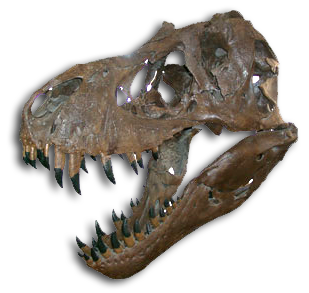Item Number
1183
Type
image
Description
Soft Pine
Size
17x10
Age
Cenozoic, lower Miocene, ~16 million years
SciId
Pinus Pinaceae
Status
in inventory
Display/Storage
Display
Building
Zuhl Museum
Original Site
Elko Co., near Jackpot, Nevada (known as Hubbard Basin)
Date Acquired
1980
Source
Burnett
Gallery/Room\Floor
Petrified Wood Gallery
Notes
Notes from Dr. Scott Singleton, Houston Museum: Soft Pine (exact species not known) Genus: Pinus Family: Pinaceae (Pine) Formation: Humboldt Fm. (lies above Jarbidge Rhylolite, which has age of 16.8 mybp) Distinguishing Characteristics: Growth rings apparent but not dominant. This is because there is only a small change in cell size between earlywood and latewood. This is in contrast to the Hard Pine subgroup that has a distinct difference in cell size through the growth ring. Pines are distinguished from other conifers by the presence of large, single resin vessels scattered throughout the growth ring. Environment of Deposition: This forest was covered by ash falls and ash flows from repeated eruptions of volcanoes associated with the rise of the Sierra Nevada Mountains. Material is found both as horizontal trunks and vertical stumps in their original growth position. A unique characteristic of the petrified forests in northern Nevada is that the replacement material is white to a creamy buff colored. Streaks and veins of black to brown penetrate the white background. The white matrix in this specimen is chalcedony, but replacement with common opal has been reported. This mode of replacement destroyed large swaths of cell structure, making it a challenge to positively identify these specimens.
Preview

Description
Notes from Dr. Scott Singleton, Houston Museum: Soft Pine (exact species not known) Genus: Pinus Family: Pinaceae (Pine) Formation: Humboldt Fm. (lies above Jarbidge Rhylolite, which has age of 16.8 mybp) Distinguishing Characteristics: Growth rings apparent but not dominant. This is because there is only a small change in cell size between earlywood and latewood. This is in contrast to the Hard Pine subgroup that has a distinct difference in cell size through the growth ring. Pines are distinguished from other conifers by the presence of large, single resin vessels scattered throughout the growth ring. Environment of Deposition: This forest was covered by ash falls and ash flows from repeated eruptions of volcanoes associated with the rise of the Sierra Nevada Mountains. Material is found both as horizontal trunks and vertical stumps in their original growth position. A unique characteristic of the petrified forests in northern Nevada is that the replacement material is white to a creamy buff colored. Streaks and veins of black to brown penetrate the white background. The white matrix in this specimen is chalcedony, but replacement with common opal has been reported. This mode of replacement destroyed large swaths of cell structure, making it a challenge to positively identify these specimens. 12x12
Keywords
Soft Pine Notes from Dr. Scott Singleton, Houston Museum: Soft Pine (exact species not known) Genus: Pinus Family: Pinaceae (Pine) Formation: Humboldt Fm. (lies above Jarbidge Rhylolite, which has age of 16.8 mybp) Distinguishing Characteristics: Growth rings apparent but not dominant. This is because there is only a small change in cell size between earlywood and latewood. This is in contrast to the Hard Pine subgroup that has a distinct difference in cell size through the growth ring. Pines are distinguished from other conifers by the presence of large, single resin vessels scattered throughout the growth ring. Environment of Deposition: This forest was covered by ash falls and ash flows from repeated eruptions of volcanoes associated with the rise of the Sierra Nevada Mountains. Material is found both as horizontal trunks and vertical stumps in their original growth position. A unique characteristic of the petrified forests in northern Nevada is that the replacement material is white to a creamy buff colored. Streaks and veins of black to brown penetrate the white background. The white matrix in this specimen is chalcedony, but replacement with common opal has been reported. This mode of replacement destroyed large swaths of cell structure, making it a challenge to positively identify these specimens. 1980 Cenozoic, lower Miocene, ~16 million years Small Slab
Keywords
Soft Pine Notes from Dr. Scott Singleton, Houston Museum: Soft Pine (exact species not known) Genus: Pinus Family: Pinaceae (Pine) Formation: Humboldt Fm. (lies above Jarbidge Rhylolite, which has age of 16.8 mybp) Distinguishing Characteristics: Growth rings apparent but not dominant. This is because there is only a small change in cell size between earlywood and latewood. This is in contrast to the Hard Pine subgroup that has a distinct difference in cell size through the growth ring. Pines are distinguished from other conifers by the presence of large, single resin vessels scattered throughout the growth ring. Environment of Deposition: This forest was covered by ash falls and ash flows from repeated eruptions of volcanoes associated with the rise of the Sierra Nevada Mountains. Material is found both as horizontal trunks and vertical stumps in their original growth position. A unique characteristic of the petrified forests in northern Nevada is that the replacement material is white to a creamy buff colored. Streaks and veins of black to brown penetrate the white background. The white matrix in this specimen is chalcedony, but replacement with common opal has been reported. This mode of replacement destroyed large swaths of cell structure, making it a challenge to positively identify these specimens. 1980 Cenozoic, lower Miocene, ~16 million years Small Slab


